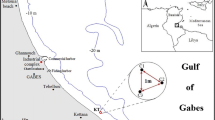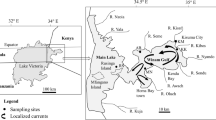Abstract
Amongst a plethora of threats to seagrass ecosystems, contamination with heavy metals may well be one of the most significant. We therefore set out to track contamination levels with Cu, Zn, Pb and Cd in the principal autotrophic compartments and sediments of a meadow of Posidonia oceanica in the Gulf of Naples, Mediterranean Sea. With respect to metal levels, leaves and their associated epibiota are certainly not a homogenous compartment, as might perhaps be inferred from the common use of the term “leaf–epiphyte complex” in the literature. Save for Cu, all metal species analysed showed appreciable differences in concentration between seagrass leaves and epibiota. These results give strength to our argument that in ecotoxicological work leaves and epibiota should not be treated as a single unit. Although absolute differences in trace-metal levels among sampling periods varied somewhat with the specific component analysed (i.e. macrophyte organs, epibiota, sediment), an overall trend of markedly higher heavy-metal levels during the winter season is a striking one. Whilst annual cycles in growth dynamics of the seagrasses explain a significant fraction of the temporal variance, seasonality in productivity is a doubtful explanation for similar patterns in non-living sedimentary components; consideration of additional variables therefore seems sensible. As variables with consistent explanatory powers we suggest: (1) seasonal cycles in storm frequency and amplitude which remobilise metals bound in the sediments of the sea floor, and (2) increased precipitation during the cold season which may significantly increase marine metal levels through elevated weathering of rocks and elevated fluvial inputs of anthropogenic contaminant loads. Whereas Cd and Pb concentrations in seagrass leaves from the Gulf of Naples fall within the range for coastal areas subjected to low levels of heavy-metal pollution, Cu and Zn reach levels typical of highly contaminated regions, such as the waters bordering major coastal cities. Any direct comparisons of the pollution status of seagrass beds between different geographic areas are, however, likely to be confounded by the indiscriminate application of the “leaf–epiphyte complex”: the magnitude of the confounding effect depends on the ratio of epibiota/leave biomass, time of sampling, and metal species analysed.
Similar content being viewed by others
Author information
Authors and Affiliations
Additional information
Received: 15 May 1997 / Accepted: 2 February 1998
Rights and permissions
About this article
Cite this article
Schlacher-Hoenlinger, M., Schlacher, T. Accumulation, contamination, and seasonal variability of trace metals in the coastal zone – patterns in a seagrass meadow from the Mediterranean. Marine Biology 131, 401–410 (1998). https://doi.org/10.1007/s002270050333
Issue Date:
DOI: https://doi.org/10.1007/s002270050333




